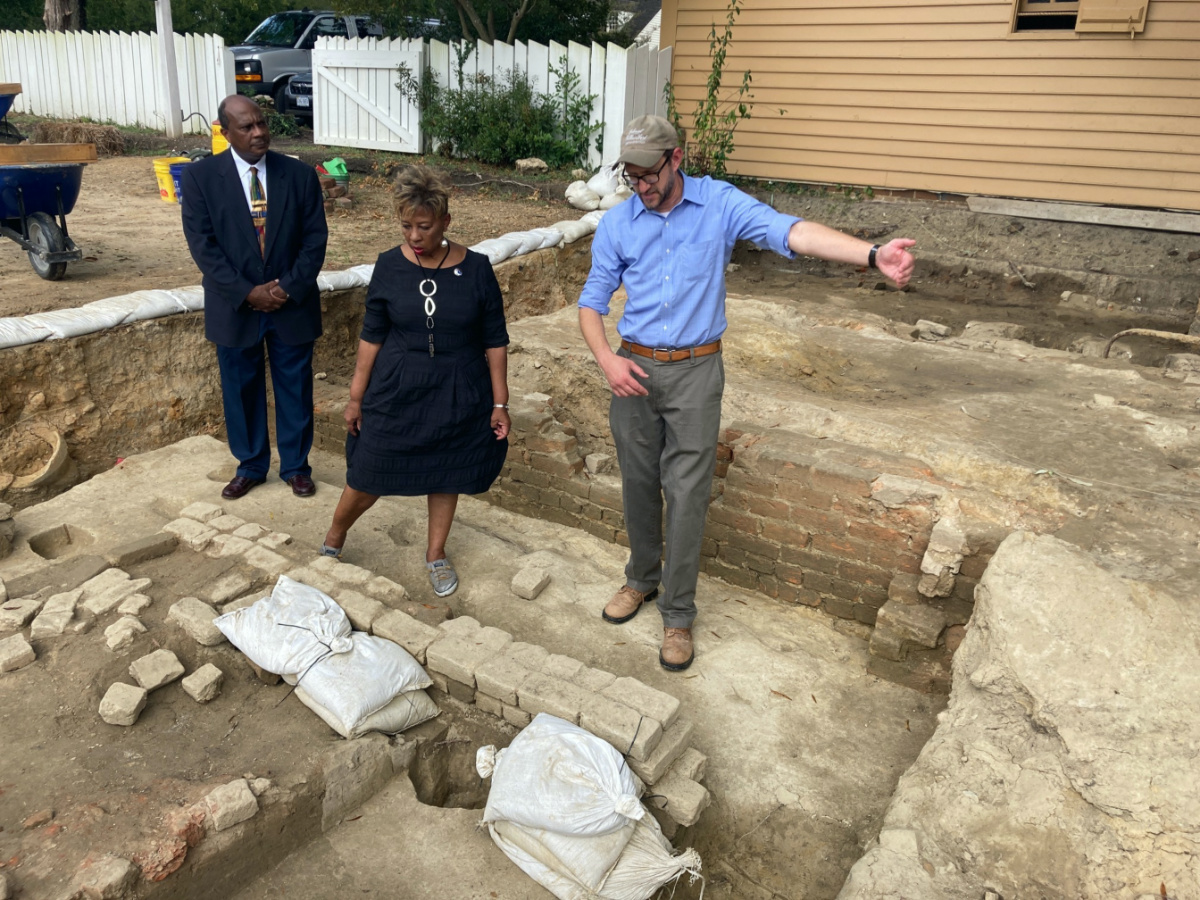United States
AP
Three men whose graves were found at the original site of one of the nation’s oldest Black churches were members of its congregation in the early 19th century, a team of archaeologists and scientists in Virginia announced last week
The First Baptist Church was formed in 1776 by free and enslaved Black people in Williamsburg, Virginia’s colonial capital. Members initially gathered in fields and under trees in defiance of laws that prevented African Americans from congregating.

From left, Reginald F Davis, pastor of First Baptist Church, Connie Matthews Harshaw, a member of First Baptist, and Jack Gary, Colonial Williamsburg’s director of archaeology, stand at the brick-and-mortar foundation of one the oldest Black churches in the US on 6th October, 2021, in Williamsburg, Virginia. Experts announced on Thursday, 6th April, 2023, that three men whose graves were found at the site were members of the church in the early 19th Century. PICTURE: AP Photo/Ben Finley, File photo.
The church’s original brick foundation was uncovered in 2021 by archaeologists at Colonial Williamsburg, a living history museum that now owns the land. The excavation of graves began last year in partnership with First Baptist’s descendant community.
More than 60 burial plots have been identified. Thursday’s announcement confirmed what oral histories had long told – that previous generations were buried on the land before it was paved over in the 20th century.
“Now we know they’re ours – they’re ours,” church member Connie Matthews Harshaw said last Thursday. “Those people under that soil are of African descent. We go from there.”
Three sets of remains were chosen for examination. They underwent DNA testing, bone analysis and the evaluation of archaeological evidence that was found, including 19th century coffin nails. The wood from the hexagonal coffins is long gone.
Only one set of remains could provide adequate DNA, which can indicate race, said Raquel Fleskes, a post-doctoral fellow at the University of Connecticut who conducted the analysis.
Those remains belonged to a Black man between the ages of 16 and 18 who stood five feet, four inches tall. His grave contained a clothing button that was made from animal bone and still carried some cotton fiber, said Jack Gary, Colonial Williamsburg’s director of archaeology.
The young man’s grave appeared to be marked by an upside-down, empty wine bottle. His coffin was likely moved from a previous location based on the large number of nails – possibly used to reinforce the coffin – and the jumbled way his bones came to rest.
The young man’s teeth indicated some kind of stress, which could have been malnutrition or disease, said Joseph Jones, a research associate with William & Mary’s Institute for Historical Biology.
“Childhood health is a pretty good indicator of a population,” Jones added.
Michael Blakey, the institute’s director, added that few African Americans in Williamsburg were free at the time.
“It either represents the conditions of an enslaved childhood or far less likely – but possibly – conditions for a free African American in childhood,” Blakey said.
We rely on our readers to fund Sight's work - become a financial supporter today!
For more information, head to our Subscriber's page.
The two other sets of remains belonged to men between the ages of 35 to 45 and possibly older, based on the analyses of their bones and teeth.
One of them stood five feet, eight inches and was possibly the oldest of the three. His remains were found with a copper straight pin that likely bound clothing or a funeral shroud.
The other man stood five feet, seven inches and was buried in a vest and trousers. His leg bones indicated the repetitive use of certain muscles, suggesting the heavy labour of someone who was enslaved.
The graves in Williamsburg are among Black burial grounds and cemeteries that are scattered throughout the nation and tell the story of the country’s deep past of slavery and segregation. Many Black Americans were excluded from white-owned cemeteries and built their own burial spaces, often as a form of resistance.
Descendants are working to preserve these grounds and cemeteries, many of which are at risk of being lost and lack support.
“All over the country there has been reckless disregard for African American bodies,” said Harshaw, of First Baptist.
“We are now becoming an example to the rest of the country,” she said. “We’re getting interest from everywhere, with people saying, ‘Wait a minute, how do you guys do this?’”
PREVIOUSLY: Oldest schoolhouse for Black children in US moving to museum
The church’s original meeting house was destroyed by a tornado in 1834. First Baptist’s second structure, built in 1856, stood there for a century.
But an expanding Colonial Williamsburg museum bought the property in 1956 and turned it into a parking lot.
The museum tells the story of Virginia’s late 1700s capital through colonial-era buildings and interpreters. But it failed to tell First Baptist’s story.
Founded in 1926, the museum did not tell Black stories until 1979, even though more than half of the people who lived in the colonial capital were Black, and many were enslaved.
In recent years, Colonial Williamsburg has boosted its efforts to tell a more complete story, placing a growing emphasis on African-American history.
The museum plans to recreate First Baptist’s original meeting house on the land where it once stood, said Gary, the museum’s director of archaeology.
“A big part of that is to commemorate the space where the burials are located,” he said.






